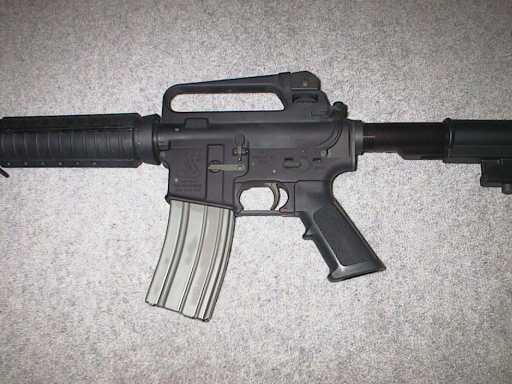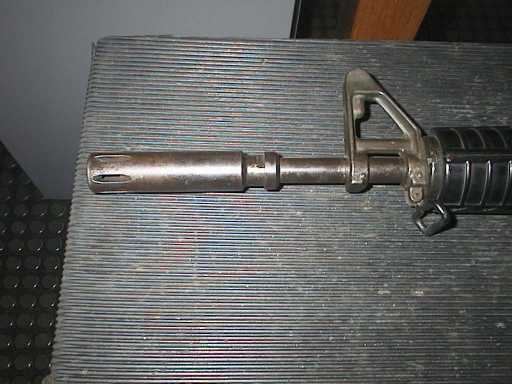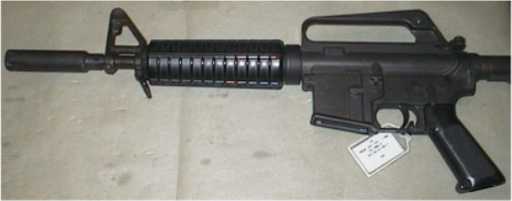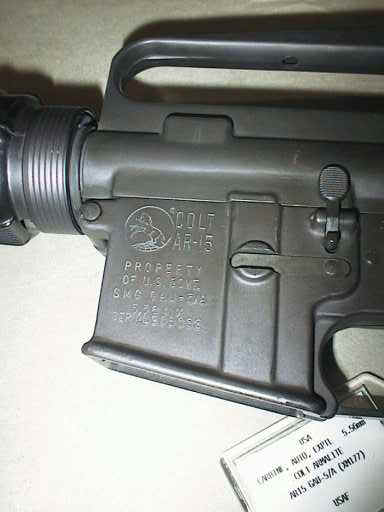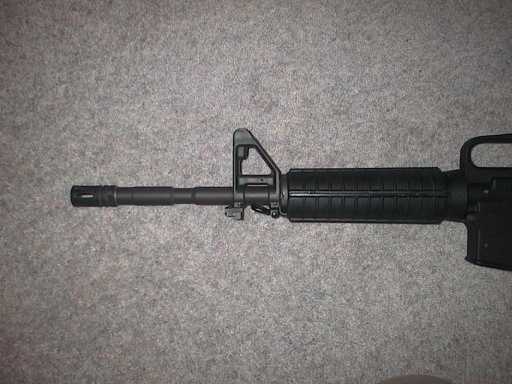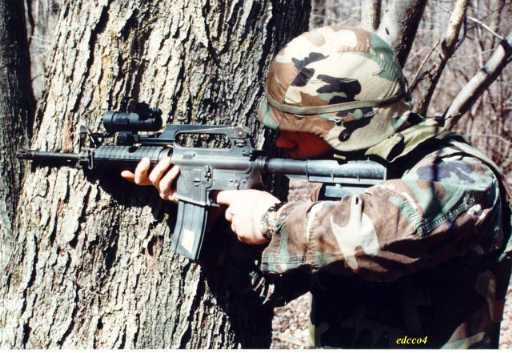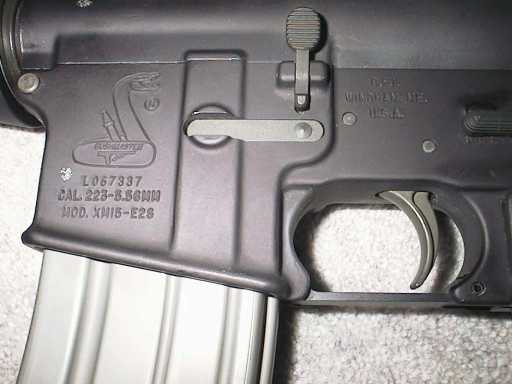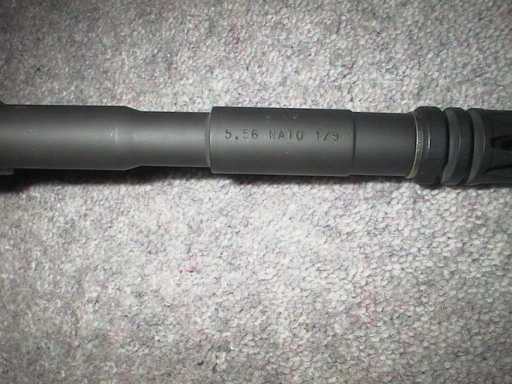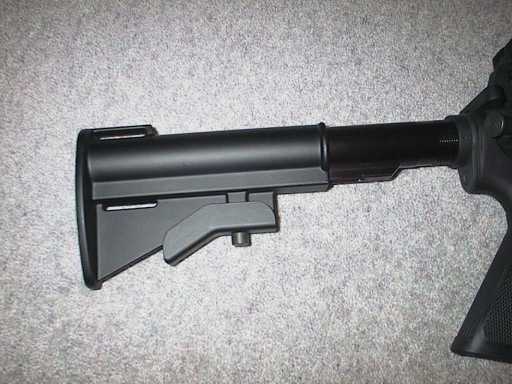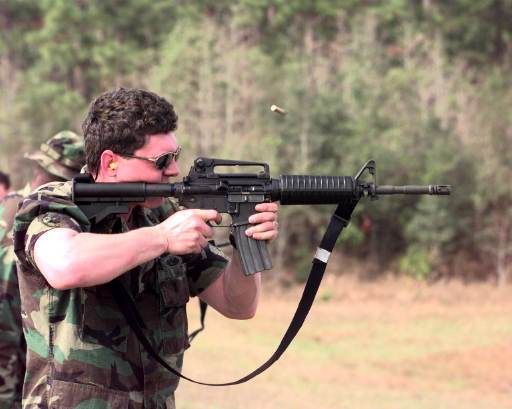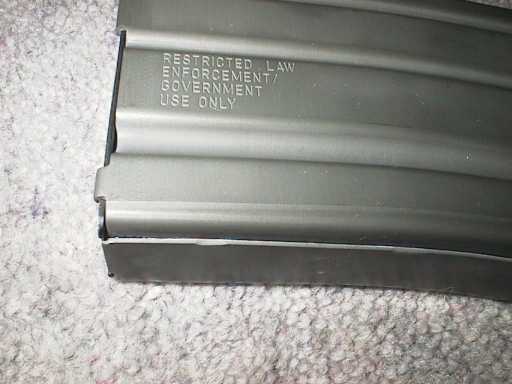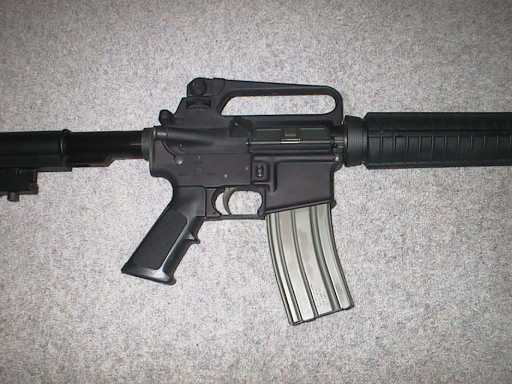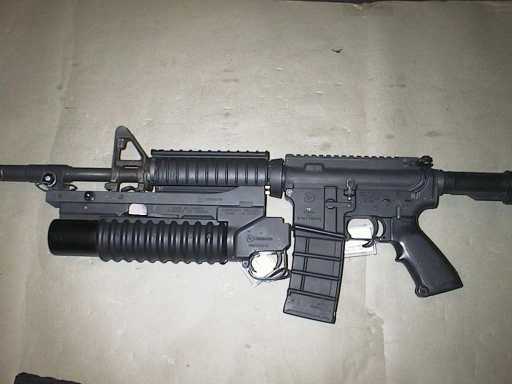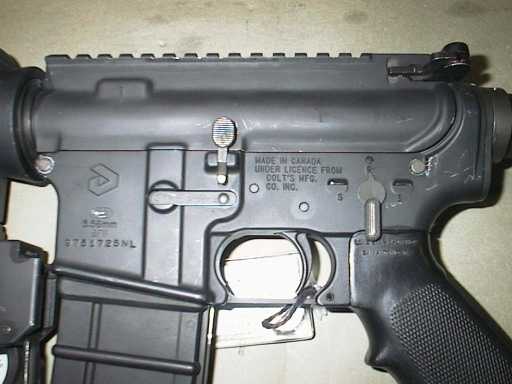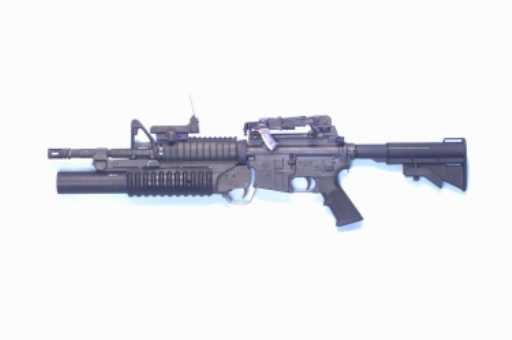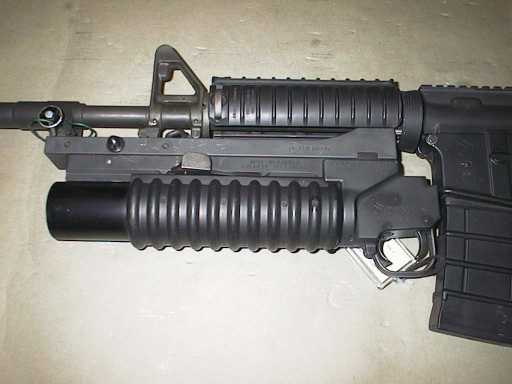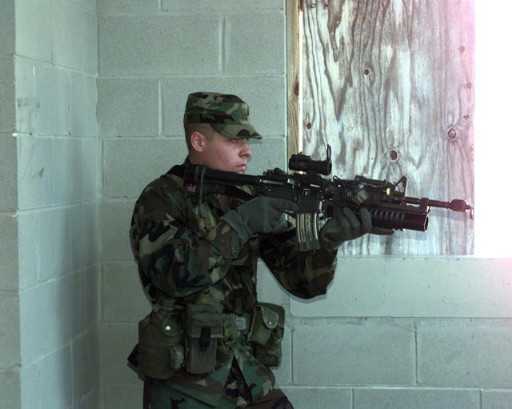[This review was originally published on the Deactivated Guns Collector’s Association website in December 2000. – Ed.]
And on to the latest chapter in the AR-15 saga!
The M4 carbine has an interesting history that is worth relating, so here goes:
In 1966 a requirement developed in the US Army for a shortened version of the M16, primarily for use by Special Forces who needed a smaller weapon for covert use, e.g. Long Range Reconnaissance Patrols (LRRPs). This involved jumping into jungles and so forth where a long rifle could easily be bent and was too heavy. Colt’s developed a derivative of the M16 that was initially called the XM177, that differed from the original M16 in that it had a ten inch barrel with a long flash suppressor that incorporated expansion chambers to reduce the deafening muzzle blast from the short barrel, a telescoping stock, and a redesigned round handguard held in place with a wedge-shaped slip ring to allow easier removal of the handguard halves for maintenance. A version with the forward bolt assist favoured by the Army was called the XM177E1. Together they were known as the “CAR-15” project, and that was the name many of the troops called them in Vietnam, although the guns were often stamped “Commando”, and they are often called the Colt Commando as well.
Only a few thousand of these guns were made, due to serious problems with them. The muzzle blast was still deafening and blinding even with the clever flash hider/suppressor, bullets would yaw and “keyhole” when hitting the target (because of insufficient stabilisation, apparently, and also debris clogging the suppressor), the cyclic rate was all over the place due to inconsistent gas pressure at the gas port (because the gas port was so close to the muzzle) and so on.
Colt redesigned the XM177 and XM177E1 into the XM177E2 which had certain improvements such as a slightly longer 11.5 inch barrel, but it too suffered from the same problems and the Army ditched the project. Undeterred, Colt’s tried to sell the XM177E2 abroad, but the Bureau of Alcohol, Tobacco and Firearms had classified the flash hider as a sound suppressor, and in a bid to stop terrorists (supposedly, more likely the Israeli Mossad) from acquiring silencers the US Govt. banned their export, inadvertently stopping Colt’s from being able to sell the XM177E2 abroad. The picture shows a close-up of the end of the newer 11.5 inch barrel, note the unusual washer used to lock the flash suppressor in place (I think this may have been used to assist in launching rifle grenades):
The only US service to officially adopt the XM177 was the Air Force, which classified it as the GAU-5/A, and used it for USAF base security and special operations, but only in very small numbers. The gun pictured below has the original ten inch barrel:
The picture shows a Strategic Air Command guard during the mid-eighties, armed with a GAU-5/A/A, the additional “/A” indicates this is a later model with the 11.5 inch barrel and suppressor from the XM177E2. Note the lack of a bolt assist:
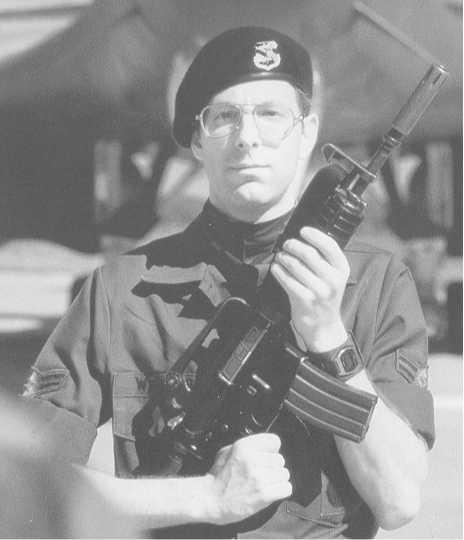
The markings on the GAU-5/A, bit difficult to read but note it says “SMG”, indicating that it was treated as a submachinegun:
During USMC testing it had been decided that the gas port in the barrel must be at least 4.5 inches from the muzzle to ensure reliable functioning, so Colt’s redesigned the XM177 into a gun they called the “M16A1 carbine”, essentially the same gun as the XM177 but fitted with a 14.5 inch barrel with a regular flash suppressor. The Colt model number is 653. The Army bought small numbers for use by the Rangers and Special Forces, and the US Navy bought a thousand for use by the SEAL teams, and the USAF bought some as well to supplement their XM177s, calling the gun the GAU-5/P – this model had no forward bolt assist. The following picture shows an Airman firing a GAU-5/P at Ft. Campbell in Kentucky, note this gun appears to have been made up from parts as it has an M4 barrel, although the receiver and stock (plastic coated aluminium) are clearly of a much earlier vintage, probably an earlier GAU-5/A that has been fitted with a new barrel:
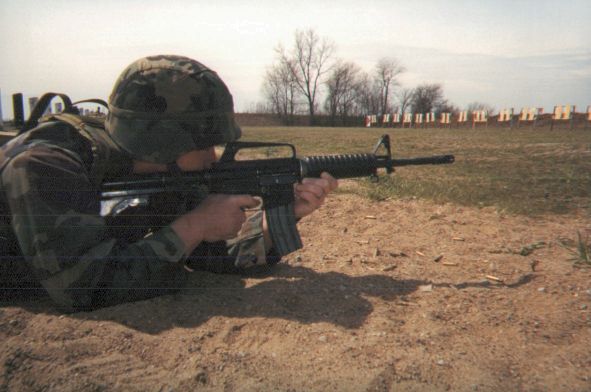
Although not bought in large numbers by US forces, as an export item the model 653 was very popular. The Israelis in particular purchased huge numbers of 653 carbines, and they still use them. The Philippines Army uses them in large numbers as well, and it was manufactured there under license.
And so we come to the M4 carbine. Like the M16A2, the M4 started life in 1983 as a request from the US Marine Corps, and the design was finalised in 1985 (a purchase order from Abu Dhabi speeded things a long a bit). This time the USMC wanted a shorter version of the rifle for tank crews and special operations. Essentially Colt’s took the old model 653 carbine and applied the M16A2 changes to it, i.e. a 1/7 inch barrel twist rate, replacing the flash hider with a compensator, putting a fully adjustable rear sight on it, case deflector, and three-round burst mechanism.
The M4 can be easily distinguished from earlier versions by the distinctive cutout in the barrel, about an inch in front of the front sight (although be careful in identifying these guns, the USAF converted some of their GAU-5s by only replacing the barrel, as illustrated above):
This cutout has been put there to accept the mounting bracket for the M203 grenade launcher, although I have to wonder why the gun wasn’t simply designed with a slimmer barrel from chamber to muzzle end, as it is only “heavy” for a fraction of its length from the front sight forward, and this small amount of extra “heaviness” is unlikely to lead to greater accuracy.
The USMC bought M4 carbines to begin with, although the Special Operations Command (SOCOM) was an early buyer as well, although their guns were full-auto and called the M4A1. SOCOM had earlier purchased the M16A2 carbine, essentially the same as the M4 with a standard skinny barrel – this was a precursor to the M4. The following picture shows an early Colt M4 carbine, note the standard M16A2 upper and the early smaller diameter handguards. This gun has also been fitted with an Aimpoint M68 sight and prototype mount:
Bushmaster Firearms entered the scene during Operation Desert Shield. With the imminent prospect of war, the military suddenly found themselves with a large demand for rifles. Many Army units were still armed with the M16A1, the replacement of which had only begun in 1986. With a large demand for M16A2s and M4s both from the US forces and allied forces, the Dept. of Defense approved a contract to buy a few dozen M4 carbines from Bushmaster Firearms of Maine.
Consequently, Bushmaster and Colt’s are the only companies to have supplied M4s to the US [FN was finally allowed to after the TDP was handed over to the DoD in 2011 – Ed.]. Bushmaster M4s have distinctive markings:
Note the rattlesnake emblem. This particular gun is not a US issue gun, but it is essentially identical except for the commercial markings. The selector is marked “SAFE/SEMI/AUTO” although it does have the 3-round burst fire mechanism.
Interestingly, the rifling twist on this commercial example is slower than the NATO standard on the military M4s, being 1 turn in 9 inches, as illustrated on the barrel:
Just above this marking you can just make out the “B MP” marking, indicating a barrel proof (and thus manufacture) by Bushmaster. A small point but I find it interesting as all the Colt barrels are marked “C MP” obviously. The “MP” stands for “magnetic particle” inspection.
A 1/9 twist does make vastly more sense on a gun like this, because it essentially replaces the submachinegun that tankers used to be issued with. It is far more likely to be fired continuously in burst-fire mode than an M16A2 rifle carried by a rifleman would be. The slower rifling twist means slower bore erosion (as there is less resistance to the bullet going down the barrel). Bore erosion is exacerbated by continuous full-auto fire (because the metal of the barrel gets softer as it heats up). However, military-issue M4s come with the same 1/7 twist as the M16A2, which leads to faster bore erosion. The official explanation for this is that the 1/7 twist is needed for the longer tracer round, however there is no real need for the tracer to be fired from the M4, and frankly at the short ranges the M4 is likely to be used, the tracer fired from a 1/9 twist will not be that far from the point of impact of the standard ball round. Colt’s tried to impress this point on the US Dept. of Defense when the M16A2 was adopted, but were rebuffed, because the 1/7 twist is the NATO standard, so that was that.
This M4 is made to the earliest M4 specification. Current M4 carbines differ in having a four-position collapsible buttstock (as opposed to this gun’s two position stock – the very latest guns have six-position stocks), and also have a detachable carry handle to allow easier mounting of scopes (unfortunately the front sight is not detachable, so the front sight obscures the sight picture through the scope somewhat). Later M4s also have a different rear sight elevation wheel that only goes up to 600 yards as opposed to the 800 yard M16A2-type wheel on earlier M4s (still a ridiculous distance to be using a carbine at!)
The Special Forces were unhappy with the burst-fire device and so another M4 was adopted, the M4A1, which differs in having the ability to fire fully-automatically, rather than only three-shot burst-fire. There had been complaints from the Army about the burst-fire device since the adoption of the M16A2, because it doesn’t reset when the trigger is released if only one or two shots are fired. I’m not sure whether this change to ordinary full-auto was a good idea or not, because apparently SOCOM have been unhappy that the M4A1’s barrel gets too hot and there are cook-offs when Special Forces personnel attempt to fire six or more magazines through the gun continuously on fully-automatic! The M4 is not an MP5. MP5 submachineguns can fire tens of thousands, even hundreds of thousands of rounds without a problem on full-auto, but 5.56mm NATO is a much higher pressure round and the M4 is a carbine and meant to be used as such, not a machinegun!
As a consequence, many M4A1s are now fitted with a heavier, thicker barrel, which has flats on the side to allow the M203 mount to fit on it. In addition, another new feature of recent M4s and M4A1s is a thicker handguard with double heat shields, although SOCOM seem to prefer the Knight’s Armament RIS, or later versions, such as the RAS (although not all M4A1s are used by SOCOM):
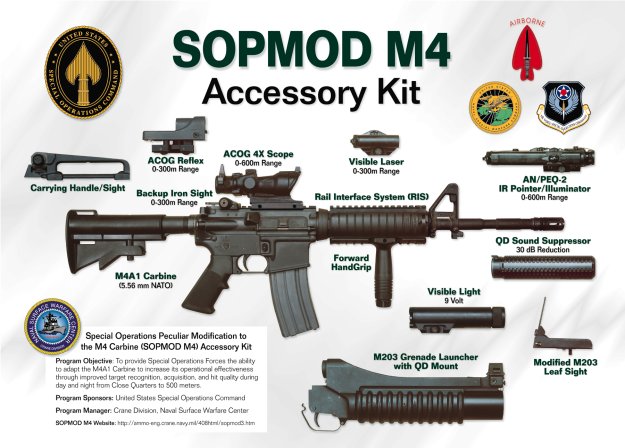
It looks impressive, but the standard M4 and even this enhanced version do not have night sights (i.e. a luminous element in the iron sights – although the ACOG does have an illuminated recticle), this is a rather odd omission on a modern military weapon.
The following picture shows a soldier firing a current issue M4A1 carbine, note the modular upper receiver and the thicker, double heat-shield handguards:
Here is a close-up of the newer M4 “enhanced” handguard below a standard M16A2 handguard, note the double liner in the M4 handguard:
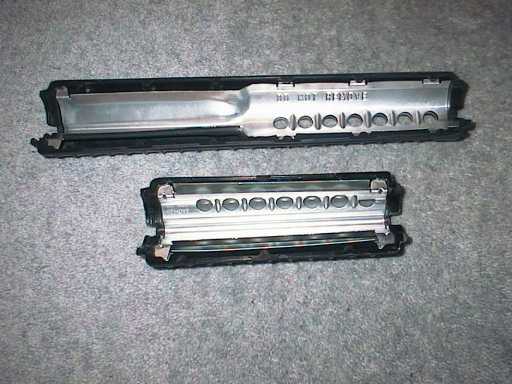
Here is a shot from the front that illustrates the thickness of the new M4 handguard:

Something that did make me laugh were the markings on the magazine:
This stupidity as a result of the 1994 Federal ban on “assault weapons” in the US (which has now expired). Machinegun manufacture was banned in 1986 (for sale to civilians), but because the bans are two different laws, the fully-automatic guns don’t have to have any special markings, whereas the semi-auto guns and all new magazines made during the ban have to have the markings in the picture. Doesn’t make sense but gun laws rarely do.
The US Army stated in 1998 that they intend to standardise on the M4 as a replacement for the M16A2, the M3A1 submachinegun and some M9 pistols. The reasoning behind this is not clear, the official explanation from the US Army is that the M4 is lighter than the M16A2 and can engage targets effectively out to 200m, which is all that is necessary. Another explanation offered is that the reduced weight of the M4 helps when the “Land Warrior” electronic battle gear is used, but this is not standard issue yet and may well never be. Another explanation that has been offered and sounds plausible is that some of the Generals weren’t happy with FN getting the contract to supply M16A2s in 1988 (presumably because FN is foreign-owned, who knows), after they beat Colt’s in the bidding for US Army contracts. Adopting a different gun, the M4, gave the Army a way around their contract with FN. The Army had apparently already tried this with the M16A4 (essentially an M16A2 with a detachable carry handle) but it wasn’t different enough to create a justification for wholesale replacement of the M16A2.
There has been a great deal of controversy about the procurement of the M4 carbine. FN has sued the US Govt., saying the sole source procurement was unfair, however the courts ruled against them, saying essentially that the technical information on the M4 is proprietary to Colt’s, and the contract is thus legal as the Govt. cannot release the technical information to anyone else until 2011.
This still sounds fishy to me and a lot of other people. Even if you take Colt’s statements about the technical information being proprietary at face value, there are still two big questions that don’t have a good answer. The first is why does the US Army feel the need to replace its rifle with a firearm that is virtually identical and costs more? ($457 for an M16A2 and $523 for an M4 according to 1996 contract awards.) Certainly the USMC seems happy enough to keep the M16A2 (although recently they have stated new contracts will be for the M16A4 – but it’s still not the M4), and the USAF doesn’t feel the need to splurge out millions on new guns. (The USMC did purchase a sizable number of M4s for their Force Recon units, I will be interested to see how they cope with it on their 500 yard qualification course!)
The USAF have simply sent all 88,000 of their M16s and XM177s to a company called CAPCO in Colorado to have new furniture and 1/7 twist barrels fitted to them. Why can’t the Army simply send their M16A2s to Colt’s (or CAPCO) to have the buttstock and upper receiver/barrel assembly replaced? Surely this would be less expensive? It would appear Colt’s must have some sympathetic soul in the Army helping them to some degree. The other big question is, why do other contractors need the Colt’s technical data package (TDP) anyway? It’s not exactly rocket science to build an M16 rifle. Bushmaster only got one contract for the M4 because apparently the TDP was improperly released to them, and Colt’s threatened to sue the US Govt. if Bushmaster got any more contracts. Presumably there is some law somewhere requiring other contractors to use the Colt’s TDP, but surely this is a law or regulation that needs changing. (If you’re wondering why Colt’s didn’t use the “proprietary information” argument in 1988 to keep the M16A2 contract, the procurement law was apparently a bit different then as the Government could claim some rights to it as they helped in the development of the M16A2 – Colt’s did try hard to claim they owned the design though).
Anyway, back to the gun at hand. The specific gun pictured was imported in 1995, but I didn’t manage to get it deactivated before the change in the deactivation specification unfortunately. I doubt there are any pre-October 1995 M4 carbines in the UK. If you want one it’s going to have to be welded solid I’m afraid. In addition the US State Dept. changed their rules in 1999 to prohibit the export of machineguns to civilians, which will make them even harder to get.
Colt M4s are extremely rare in the UK, at least at the moment, I suspect in the near future surplus M4s from Saudi Arabia, Kuwait and Abu Dhabi will start showing up. I bought this one directly from Bushmaster and imported it with the help of a Section 5 dealer. It was very reasonably priced, but it would cost a lot more to do it now because the Home Office have tightened the shipping regulations on Section 5 firearms. Oh well, that’s what gun collectors like, a rare gun!
Here are some more pictures I took in the Pattern Room. These are of a Diemaco C8 “Special Forces Weapon” carbine. Diemaco made the M16-series guns under licence for the Canadian military, although they sold substantial numbers in the Netherlands, Denmark and also to the British armed forces. Elements of 5 Airborne Brigade and also the Royal Marines and 22 SAS have used the Diemaco C7 and C7A1 rifles for some time, and also have some of these carbines now as well. Diemaco has since been taken over by Colt’s and is now called: “Colt’s Canada”.
The C8 SFW pictured has been fitted with the Knight’s Armament RIS and Diemaco’s version of the M203PI grenade launcher. Note the exceptionally complex mounting system used on this gun, Colt’s avoided this on the M4 with the cutout in the barrel that allows the standard M203 mount. I do prefer the plastic Thermold magazines, although a friend of mine in the Dutch Army said they have had problems with them because of the thicker feed lips (there have been various revisions of the design). I haven’t had any problems with mine though:
A close up of the receiver of this carbine, note the markings, especially on the selector. This is the first Diemaco gun I have seen fitted with the 3-shot burst mechanism, the selector markings are “S”, “R” (for “repetition”), and “3”. The Canadian Army does not use the 3-shot burst mechanism, preferring full-auto (but the Dutch Army apparently does use it, to a degree – this gun has a Dutch Army serial number although it is not a Dutch Army gun). Another curious feature of this gun is the Lone Star Ordnance pistol grip, which has a compartment into which you can barely fit some cleaning equipment:
This blurry picture shows a Colt M4 fitted with a standard M203 grenade launcher:
Compare it to this nightmare from Diemaco:
Note that the SAS and other special forces unit have adopted this gun now as the L119A1 special forces weapon; but they opted for the Heckler and Koch AG36 grenade launcher instead. Here is a somewhat blurry picture of one:
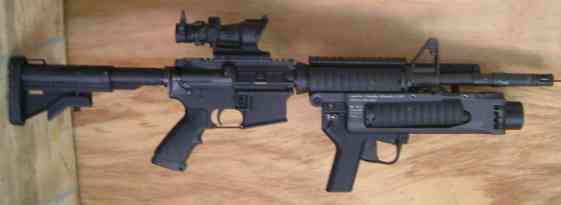
Say “cheese”. This soldier appears unaware this his M4 is fitted with the wrong blank-firing adapter. Because of the different gas pressure needed due to the shorter barrel, the M4 has its own BFA, which is painted yellow. Note also the shorter M203PI grenade launcher. The M68 Aimpoints are quite fun, I will get around to doing a review of them eventually on the Cybershooters website:

